Munson B.R. Fundamentals of Fluid Mechanics
Подождите немного. Документ загружается.


and the fluid velocity is zero on the wetted perimeter, where a wall shear stress, is developed.
This shear stress is seldom uniform along the wetted perimeter, with typical variations as are
indicated in Fig. 10.9b.
Fortunately, reasonable analytical results can be obtained by assuming a uniform velocity
profile, V, and a constant wall shear stress, Similar assumptions were made for pipe flow
situations 1Chapter 82, with the friction factor being used to obtain the head loss.
t
w
.
t
w
,
10.4 Uniform Depth Channel Flow 547
F I G U R E 10.9 Typical velocity and
shear stress distributions in an open channel:
(a) velocity distribution throughout the cross section,
(b) shear stress distribution on the wetted perimeter.
Lines of
constant
velocity
Centerline
velocity
profiles
u
y
(a)
(
b)
u
y
Actual
Uniform
τ
w
= shear stress
distribution
τ
w
Fluids in the News
Plumbing the Everglades Because of all of the economic de-
velopment that has occurred in southern Florida, the natural
drainage pattern of that area has been greatly altered during the
past century. Previously there was a vast network of surface
flow southward from the Orlando area, to Lake Okeechobee,
through the Everglades, and out to the Gulf of Mexico. Cur-
rently a vast amount of freshwater from Lake Okeechobee and
surrounding waterways (1.7 billion gallons per day) is sluiced
into the ocean for flood control, bypassing the Everglades. A
new long-term Comprehensive Everglades Restoration Plan is
being implemented to restore, preserve, and protect the south
Florida ecosystem. Included in the plan are the use of numer-
ous aquifer-storage-and-recovery systems that will recharge the
ecosystem. In addition, surface water reservoirs using artificial
wetlands will clean agricultural runoff. In an attempt to im-
prove the historical flow from north to south, old levees will be
removed, parts of the Tamiami Trail causeway will be altered,
and stored water will be redirected through miles of new pipes
and rebuilt canals. Strictly speaking, the Everglades will not be
“restored.” However, by 2030, 1.6 million acres of national
parkland will have cleaner water and more of it. (See Problem
10.77.)
10.4.2 The Chezy and Manning Equations
The basic equations used to determine the uniform flowrate in open channels were derived many
years ago. Continual refinements have taken place to obtain better values of the empirical coefficients
involved. The result is a semiempirical equation that provides reasonable engineering results. A
more refined analysis is perhaps not warranted because of the complexity and uncertainty of the
flow geometry 1i.e., channel shape and the irregular makeup of the wetted perimeter, particularly
for natural channels2.
Under the assumptions of steady uniform flow, the x component of the momentum equation
1Eq. 5.222applied to the control volume indicated in Fig. 10.10 simply reduces to
since There is no acceleration of the fluid, and the momentum flux across section 112is
the same as that across section 122. The flow is governed by a simple balance between the forces
in the direction of the flow. Thus, or
(10.15)F
1
⫺ F
2
⫺ t
w
P/ ⫹ w sin u ⫽ 0
兺F
x
⫽ 0,
V
1
⫽ V
2
.
兺F
x
⫽ rQ1V
2
⫺ V
1
2⫽ 0
For steady, uniform
depth flow in an
open channel
there is no fluid
acceleration.
JWCL068_ch10_534-578.qxd 9/30/08 8:33 AM Page 547
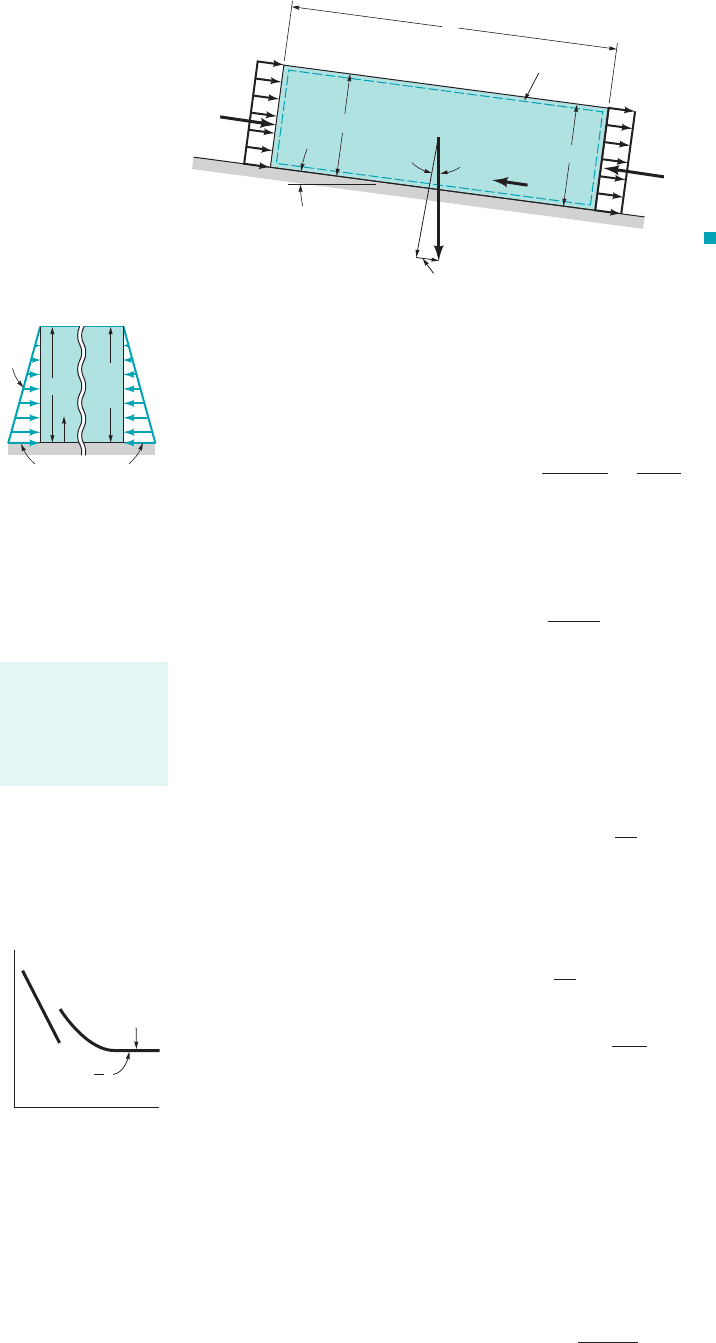
where and are the hydrostatic pressure forces across either end of the control volume, as shown
by the figure in the margin. Because the flow is at a uniform depth it follows that
so that these two forces do not contribute to the force balance. The term is the component of
the fluid weight that acts down the slope, and is the shear force on the fluid, acting up the slope
as a result of the interaction of the water and the channel’s wetted perimeter. Thus, Eq. 10.15 becomes
where we have used the approximation that since the bottom slope is typically
very small 2. Since and the hydraulic radius is defined as the
force balance equation becomes
(10.16)
Most open-channel flows are turbulent rather than laminar. In fact, typical Reynolds numbers
are quite large, well above the transitional value and into the wholly turbulent regime. As was
discussed in Chapter 8, and shown by the figure in the margin, for very large Reynolds number pipe
flows 1wholly turbulent flows2, the friction factor, f, is found to be independent of Reynolds number,
dependent only on the relative roughness, , of the pipe surface. For such cases, the wall shear
stress is proportional to the dynamic pressure, and independent of the viscosity. That is,
where K is a constant dependent upon the roughness of the pipe.
It is not unreasonable that similar shear stress dependencies occur for the large Reynolds
number open-channel flows. In such situations, Eq. 10.16 becomes
or
(10.17)
where the constant C is termed the Chezy coefficient and Eq. 10.17 is termed the Chezy equation.
This equation, one of the oldest in the area of fluid mechanics, was developed in 1768 by A. Chezy
11718–17982, a French engineer who designed a canal for the Paris water supply. The value of the
Chezy coefficient, which must be determined by experiments, is not dimensionless but has the
dimensions of per time 1i.e., the square root of the units of acceleration2.
From a series of experiments it was found that the slope dependence of Eq. 10.17
is reasonable, but that the dependence on the hydraulic radius is more nearly rather than
In 1889, R. Manning 11816–18972, an Irish engineer, developed the following somewhat
modified equation for open-channel flow to more accurately describe the dependence:
(10.18)V
R
2
3
h
S
0
1
2
n
R
h
V R
h
1
2
.
V R
h
2
3
1V S
0
1
2
2
1length2
1
2
V C 2R
h
S
0
Kr
V
2
2
gR
h
S
0
t
w
Kr
V
2
2
rV
2
2,
e
D
t
w
gA/S
0
P/
gR
h
S
0
R
h
A
P,w gA/1i.e., S
0
1
sin u tan u S
0
,
t
w
w sin u
P/
w S
0
P/
t
w
P/
wsin u
F
1
F
2
1y
1
y
2
2,
F
2
F
1
548 Chapter 10 ■ Open-Channel Flow
For uniform depth,
channel flow is gov-
erned by a balance
between friction
and weight.
F I G U R E 10.10
Control volume for uniform flow
in an open channel.
F
1
V
1
(1)
θ
y
1
= y
2
= 0
τ
ᐉ
y
2
τ
Pᐉ
ᐃ
= Aᐉ
γ
ᐃ sin
θ
(2)
F
2
V
2
= V
1
x
Control surface
θ
w
f
Wholly
turbulent
Re
f = f
e
D
p(y)
Equal pressure
distributions
y
2
= y
1
y
1
y
JWCL068_ch10_534-578.qxd 9/23/08 11:52 AM Page 548

Equation 10.18 is termed the Manning equation, and the parameter n is the Manning resistance
coefficient. Its value is dependent on the surface material of the channel’s wetted perimeter and is
obtained from experiments. It is not dimensionless, having the units of or
As is discussed in Chapter 7, any correlation should be expressed in dimensionless form,
with the coefficients that appear being dimensionless coefficients, such as the friction factor for
pipe flow or the drag coefficient for flow past objects. Thus, Eq. 10.18 should be expressed in
dimensionless form. Unfortunately, the Manning equation is so widely used and has been used for
so long that it will continue to be used in its dimensional form with a coefficient, n, that is not
dimensionless. The values of n found in the literature 1such as Table 10.12were developed for SI
units. Standard practice is to use the same value of n when using the BG system of units, and to
insert a conversion factor into the equation.
Thus, uniform flow in an open channel is obtained from the Manning equation written as
(10.19)
and
(10.20)
where if SI units are used, and if BG units are used. The value 1.49 is the cube
root of the number of feet per meter: Thus, by using in meters, A in
and the average velocity is and the flowrate By using in feet, A in and
the average velocity is and the flowrate
Typical values of the Manning coefficient are indicated in Table 10.1. As expected, the
rougher the wetted perimeter, the larger the value of n. For example, the roughness of floodplain
surfaces increases from pasture to brush to tree conditions. So does the corresponding value of
the Manning coefficient. Thus, for a given depth of flooding, the flowrate varies with floodplain
roughness as indicated by the figure in the margin.
Precise values of n are often difficult to obtain. Except for artificially lined channel
surfaces like those found in new canals or flumes, the channel surface structure may be quite
complex and variable. There are various methods used to obtain a reasonable estimate of the
value of n for a given situation 1Ref. 52. For the purpose of this book, the values from Table
10.1 are sufficient. Note that the error in Q is directly proportional to the error in n. A 10%
ft
3
Ⲑ
s.ft
Ⲑ
sk ⫽ 1.49,
ft
2
,R
h
m
3
Ⲑ
s.m
Ⲑ
sk ⫽ 1,
m
2
,R
h
13.281 ft
Ⲑ
m2
1
Ⲑ
3
⫽ 1.49.
k ⫽ 1.49k ⫽ 1
Q ⫽
k
n
AR
h
2
Ⲑ
3
S
1
Ⲑ
2
0
V ⫽
k
n
R
h
2
Ⲑ
3
S
0
1
Ⲑ
2
s
Ⲑ
ft
1
Ⲑ
3
.s
Ⲑ
m
1
Ⲑ
3
10.4 Uniform Depth Channel Flow 549
The Manning equa-
tion is used to ob-
tain the velocity or
flowrate in an open
channel.
A. Natural channels
Clean and straight 0.030
Sluggish with deep pools 0.040
Major rivers 0.035
B. Floodplains
Pasture, farmland 0.035
Light brush 0.050
Heavy brush 0.075
Trees 0.15
C. Excavated earth channels
Clean 0.022
Gravelly 0.025
Weedy 0.030
Stony, cobbles 0.035
TABLE 10.1
Values of the Manning Coefficient, n (Ref. 6)
Wetted Perimeter n Wetted Perimeter n
D. Artificially lined channels
Glass 0.010
Brass 0.011
Steel, smooth 0.012
Steel, painted 0.014
Steel, riveted 0.015
Cast iron 0.013
Concrete, finished 0.012
Concrete, unfinished 0.014
Planed wood 0.012
Clay tile 0.014
Brickwork 0.015
Asphalt 0.016
Corrugated metal 0.022
Rubble masonry 0.025
Q
n
0.150.10.05
Trees
Heavy brush
Light brush
Pasture, farmland
0
JWCL068_ch10_534-578.qxd 9/23/08 11:52 AM Page 549
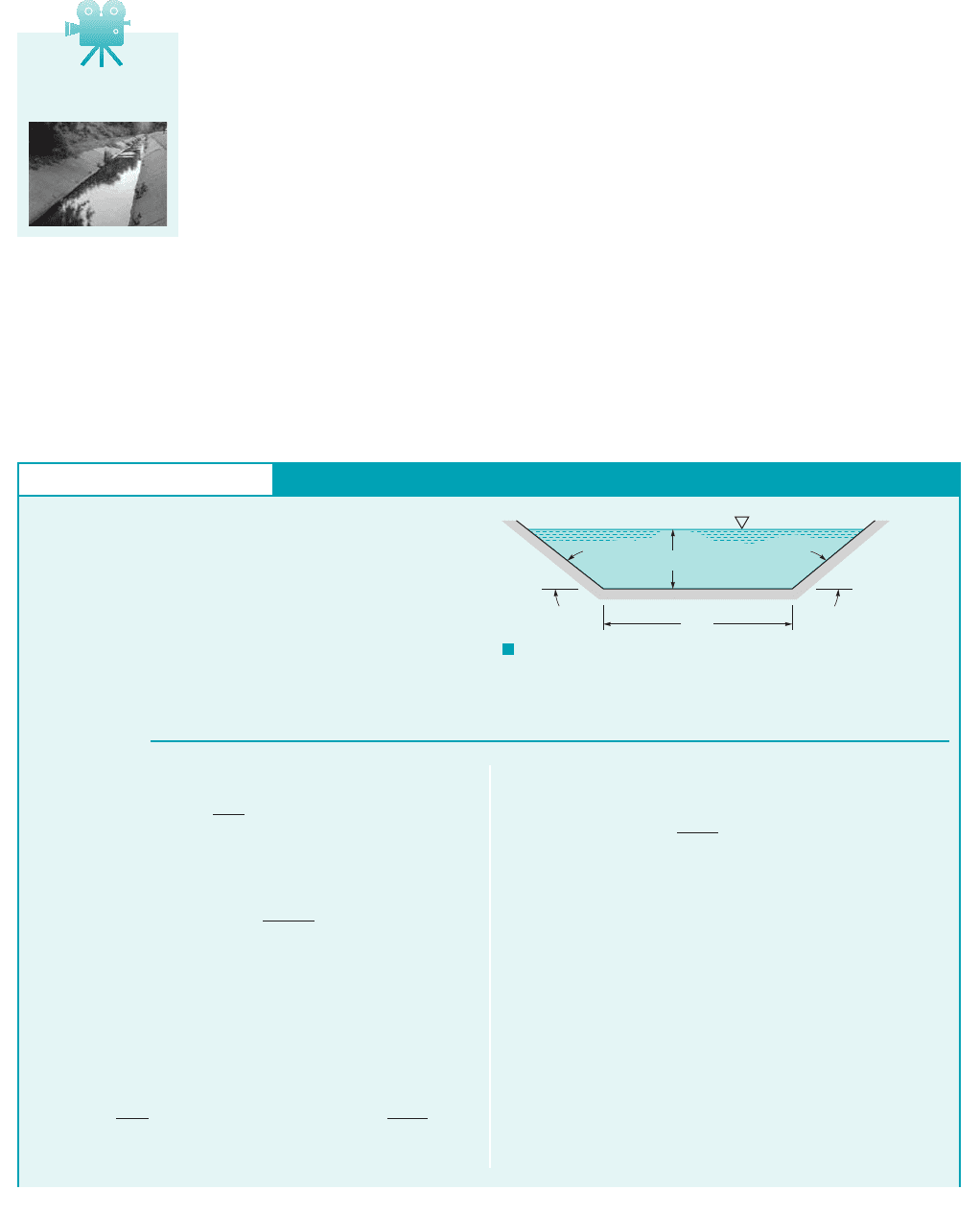
error in the value of n produces a 10% error in the flowrate. Considerable effort has been put
forth to obtain the best estimate of n, with extensive tables of values covering a wide variety
of surfaces 1Ref. 72. It should be noted that the values of n given in Table 10.1 are valid only
for water as the flowing fluid.
Both the friction factor for pipe flow and the Manning coefficient for channel flow are
parameters that relate the wall shear stress to the makeup of the bounding surface. Thus, various
results are available that describe n in terms of the equivalent pipe friction factor, f, and the surface
roughness, 1Ref. 82. For our purposes we will use the values of n from Table 10.1.
10.4.3 Uniform Depth Examples
A variety of interesting and useful results can be obtained from the Manning equation. The following
examples illustrate some of the typical considerations.
The main parameters involved in uniform depth open-channel flow are the size and shape of
the channel cross section the slope of the channel bottom the character of the material
lining the channel bottom and walls 1n2, and the average velocity or flowrate Although
the Manning equation is a rather simple equation, the ease of using it depends in part on which
variables are given and which are to be determined.
Determination of the flowrate of a given channel with flow at a given depth 1often termed
the normal flowrate for normal depth, sometimes denoted 2is obtained from a straightforward
calculation as is shown in Example 10.3.
y
n
1V or Q2.
1S
0
2,1A, R
h
2,
e
550 Chapter 10 ■ Open-Channel Flow
GIVEN Water flows in the canal of trapezoidal cross section
shown in Fig. E10.3a. The bottom drops 1.4 ft per 1000 ft of
length. The canal is lined with new finished concrete.
FIND Determine
(a) the flowrate and
(b) the Froude number for this flow.
Uniform Flow, Determine Flow Rate
E
XAMPLE 10.3
S
OLUTION
From Table 10.1, we obtain for the finished
concrete. Thus,
(Ans)
COMMENT The corresponding average velocity,
is 10.2 ft兾s. It does not take a very steep slope
for this velocity.
By repeating the calculations for various surface types 1i.e.,
various Manning coefficient values2, the results shown in Fig.
E10.3b are obtained. Note that the increased roughness causes
a decrease in the flowrate. This is an indication that for the tur-
bulent flows involved, the wall shear stress increases with sur-
face roughness. [For water at the Reynolds number
based on the 3.25-ft hydraulic radius of the channel and a
smooth concrete surface is
well into the turbulent regime.]
(b) The Froude number based on the maximum depth for the
flow can be determined from For the finished
Fr ⫽ V
Ⲑ
1gy2
1
Ⲑ
2
.
11.41 ⫻10
⫺5
ft
2
Ⲑ
s2⫽ 2.35 ⫻10
6
,
3.25 ft 110.2 ft
Ⲑ
s2
Ⲑ
Re ⫽ R
h
V
Ⲑ
n ⫽
50 °F,
tan
⫺1
10.00142⫽ 0.080°2
1S
0
⫽ 0.0014 or u ⫽
V ⫽ Q
Ⲑ
A,
Q ⫽
10.98
0.012
⫽ 915 cfs
n ⫽ 0.012(a) From Eq. 10.20,
(1)
where we have used since the dimensions are given in
BG units. For a depth of the flow area is
so that with a wetted perimeter of
the hydraulic radius is determined to be
Note that even though the channel is quite wide 1the free-
surface width is 23.9 ft2, the hydraulic radius is only 3.25 ft, which
is less than the depth.
Thus, with Eq. 1 becomes
where Q is in
ft
3
Ⲑ
s.
Q ⫽
1.49
n
189.8 ft
2
213.25 ft2
2
Ⲑ
3
10.00142
1
Ⲑ
2
⫽
10.98
n
S
0
⫽ 1.4 ft
Ⲑ
1000 ft ⫽ 0.0014,
3.25 ft.
R
h
⫽ A
Ⲑ
P ⫽27.6 ft,
P ⫽12 ft ⫹ 215
Ⲑ
sin 40° ft2 ⫽
A ⫽ 12 ft 15 ft2⫹ 5 ft a
5
tan 40°
ftb⫽ 89.8 ft
2
y ⫽ 5 ft,
k ⫽ 1.49,
Q ⫽
1.49
n
AR
h
2
Ⲑ
3
S
0
1
Ⲑ
2
F I G U R E E10.3
a
y = 5 ft
40°40°
12 ft
V10.7 Uniform
channel flow
JWCL068_ch10_534-578.qxd 9/30/08 8:33 AM Page 550
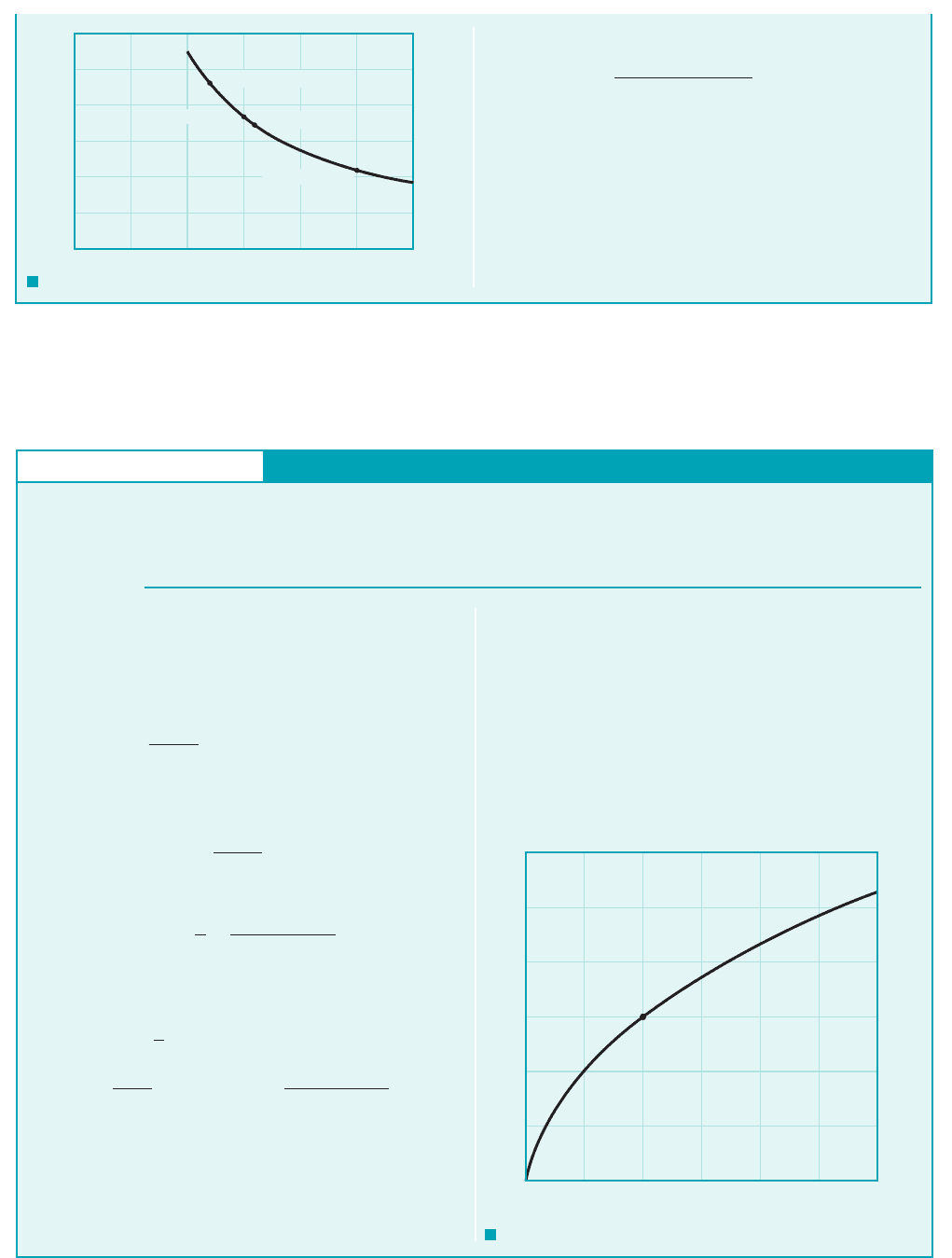
In some instances a trial-and-error or iteration method must be used to solve for the dependent
variable. This is often encountered when the flowrate, channel slope, and channel material are
given, and the flow depth is to be determined as illustrated in the following examples.
10.4 Uniform Depth Channel Flow 551
concrete case,
(Ans)
The flow is subcritical.
COMMENT The same results would be obtained for the
channel if its size were given in meters. We would use the same
value of n but set for this SI units situation.k 1
Fr
10.2 ft
s
132.2 ft
s
2
5 ft2
1
2
0.804
F I G U R E E10.3
b
1200
1000
800
600
400
200
0
0 0.005 0.01 0.015 0.02 0.025 0.03
Q, cfs
n
Finished concrete
Rubble masonry
Brickwork
Asphalt
GIVEN Water flows in the channel shown in Fig. E10.3a at a
rate of The canal lining is weedy.
Q 10.0 m
3
s.
Uniform Flow, Determine Flow Depth
E
XAMPLE 10.4
S
OLUTION
and-error methods. The only physically meaningful root of Eq. 1
1i.e., a positive, real number2gives the solution for the normal
flow depth at this flowrate as
(Ans)
COMMENT By repeating the calculations for various
flowrates, the results shown in Fig. E10.4 are obtained. Note that
the water depth is not linearly related to the flowrate. That is, if
the flowrate is doubled, the depth is not doubled.
y 1.50 m
In this instance neither the flow area nor the hydraulic radius are
known, although they can be written in terms of the depth, y.
Since the flowrate is given in m
3
/s, we will solve this problem using
SI units. Hence, the bottom width is (12 ft) (1 m/3.281 ft) 3.66 m
and the area is
where A and y are in square meters and meters, respectively. Also,
the wetted perimeter is
so that
where and y are in meters. Thus, with 1from Table
10.12, Eq. 10.20 can be written as
which can be rearranged into the form
(1)
where y is in meters. The solution of Eq. 1 can be easily obtained
by use of a simple rootfinding numerical technique or by trial-
11.19y
2
3.66y2
5
51513.11y 3.662
2
0
10.00142
1
2
1.0
0.030
11.19y
2
3.66y2 a
1.19y
2
3.66y
3.11y 3.66
b
2
3
Q 10
k
n
AR
2
3
h
S
1
2
0
n 0.030
R
h
R
h
A
P
1.19y
2
3.66y
3.11y 3.66
P 3.66 2 a
y
sin 40°
b 3.11y 3.66
A y a
y
tan 40°
b 3.66y 1.19y
2
3.66y
FIND Determine the depth of the flow.
F I G U R E E10.4
(10, 1.50)
3.0
2.5
2.0
1.5
1.0
0.5
0
0 5 10 15 20 25 30
y, m
Q, m
3
/s
JWCL068_ch10_534-578.qxd 9/23/08 11:53 AM Page 551
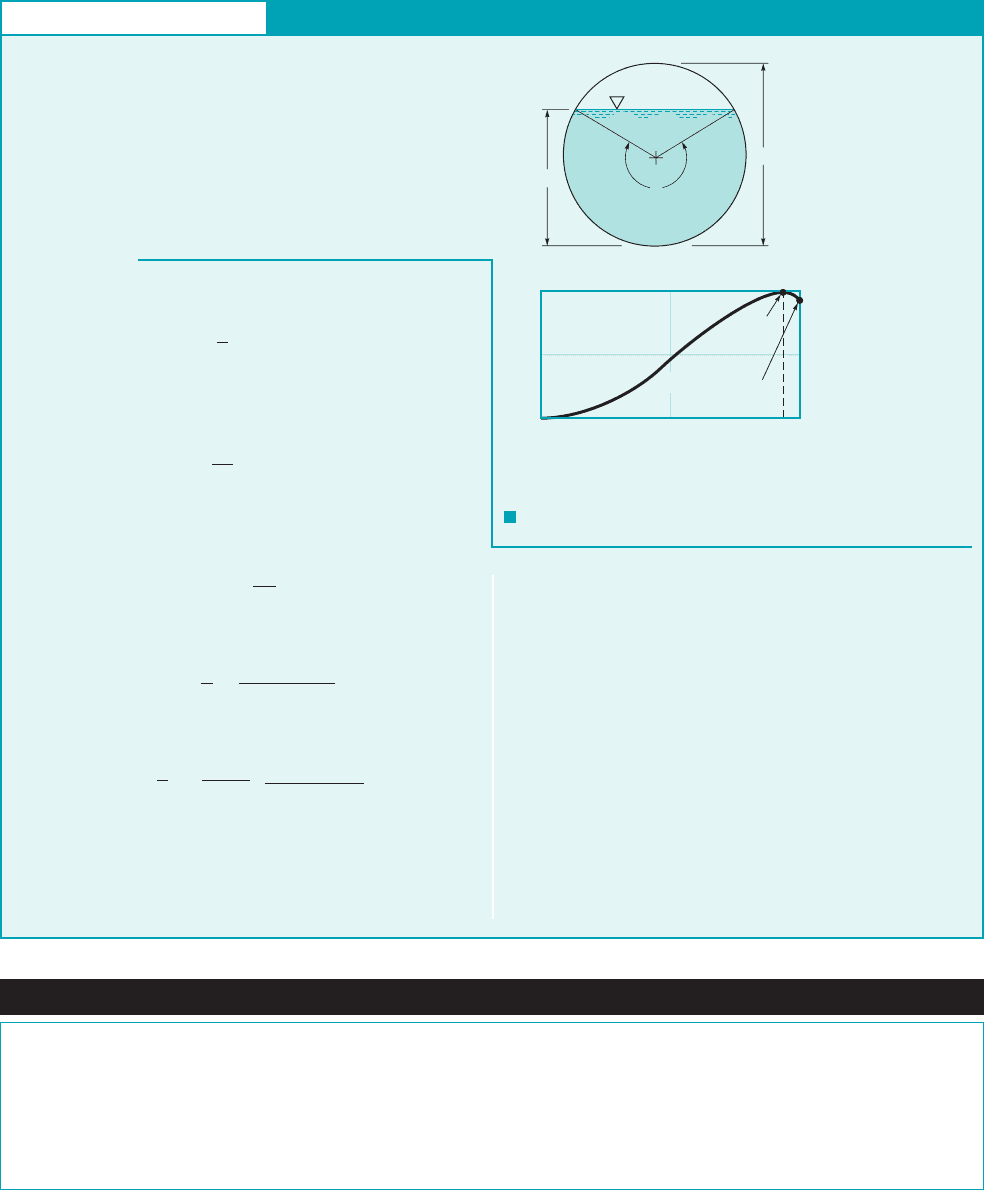
In Example 10.4 we found the flow depth for a given flowrate. Since the equation for this
depth is a nonlinear equation, it may be that there is more than one solution to the problem. For a
given channel there may be two or more depths that carry the same flowrate. Although this is not
normally so, it can and does happen, as is illustrated by Example 10.5.
552 Chapter 10 ■ Open-Channel Flow
GIVEN Water flows in a round pipe of diameter D at a depth
of as is shown in Fig. E10.5a. The pipe is laid on a
constant slope of and the Manning coefficient is n.
FIND (a) At what depth does the maximum flowrate occur?
(b) Show that for certain flowrates there are two depths possible
with the same flowrate. Explain this behavior.
S
0
,
0 y D,
Uniform Flow, Maximum Flow Rate
E
XAMPLE 10.5
S
OLUTION
It occurs when or
Thus,
(Ans)
(b) For any there are two possible depths
that give the same Q. The reason for this behavior can be seen by
considering the gain in flow area, A, compared to the increase in
wetted perimeter, P, for The flow area increase for an
increase in y is very slight in this region, whereas the increase in
wetted perimeter, and hence the increase in shear force holding
back the fluid, is relatively large. The net result is a decrease in
flowrate as the depth increases.
COMMENT For most practical problems, the slight difference
between the maximum flowrate and full pipe flowrates is negligible,
particularly in light of the usual inaccuracy of the value of n.
y ⬇ D.
0.929 6 Q
Q
max
6 1
Q Q
max
when y 0.938D
rad 303°.
u 5.28y 0.938D,Q
full
0.929Q
max
.
(a) According to the Manning equation 1Eq. 10.202the flowrate is
(1)
where n, and are constants for this problem. From geometry
it can be shown that
where the angle indicated in Fig. E10.5a, is in radians. Simi-
larly, the wetted perimeter is
so that the hydraulic radius is
Therefore, Eq. 1 becomes
This can be written in terms of the flow depth by using
A graph of flowrate versus flow depth, has the
characteristic indicated in Fig. E10.5b. In particular, the maxi-
mum flowrate, does not occur when the pipe is full;Q
max
,
Q Q1y2,
y 1D
2231 cos1u
224.
Q
k
n
S
1
2
0
D
8
3
8142
2
3
c
1u sin u2
5
3
u
2
3
d
R
h
A
P
D1u sin u2
4u
P
Du
2
u,
A
D
2
8
1u sin u2
k
S
0
,
Q
k
n
AR
2
3
h
S
1
2
0
F I G U R E E10.5
θ
y
D
(a)
Fluids in the News
Done without GPS or lasers Two thousand years before the
invention of such tools as the GPS or laser surveying equipment,
Roman engineers were able to design and construct structures that
made a lasting contribution to Western civilization. For example,
one of the best surviving examples of Roman aqueduct construc-
tion is the Pont du Gard, an aqueduct that spans the Gardon River
near Nîmes, France. This aqueduct is part of a circuitous, 50 km
long open channel that transported water to Rome from a spring
located 20 km from Rome. The spring is only 14.6 m above the
point of delivery, giving an average bottom slope of only 3 10
4
.
It is obvious that to carry out such a project, the Roman under-
standing of hydraulics, surveying, and construction was well ad-
vanced. (See Problem 10.59.)
Q
_____
Q
max
0
0
0.5
1.0
(
b)
0.5
y
__
D
Q
full
= 0.929 Q
max
Q
max
y = 0.938D
1.0
JWCL068_ch10_534-578.qxd 9/23/08 11:53 AM Page 552
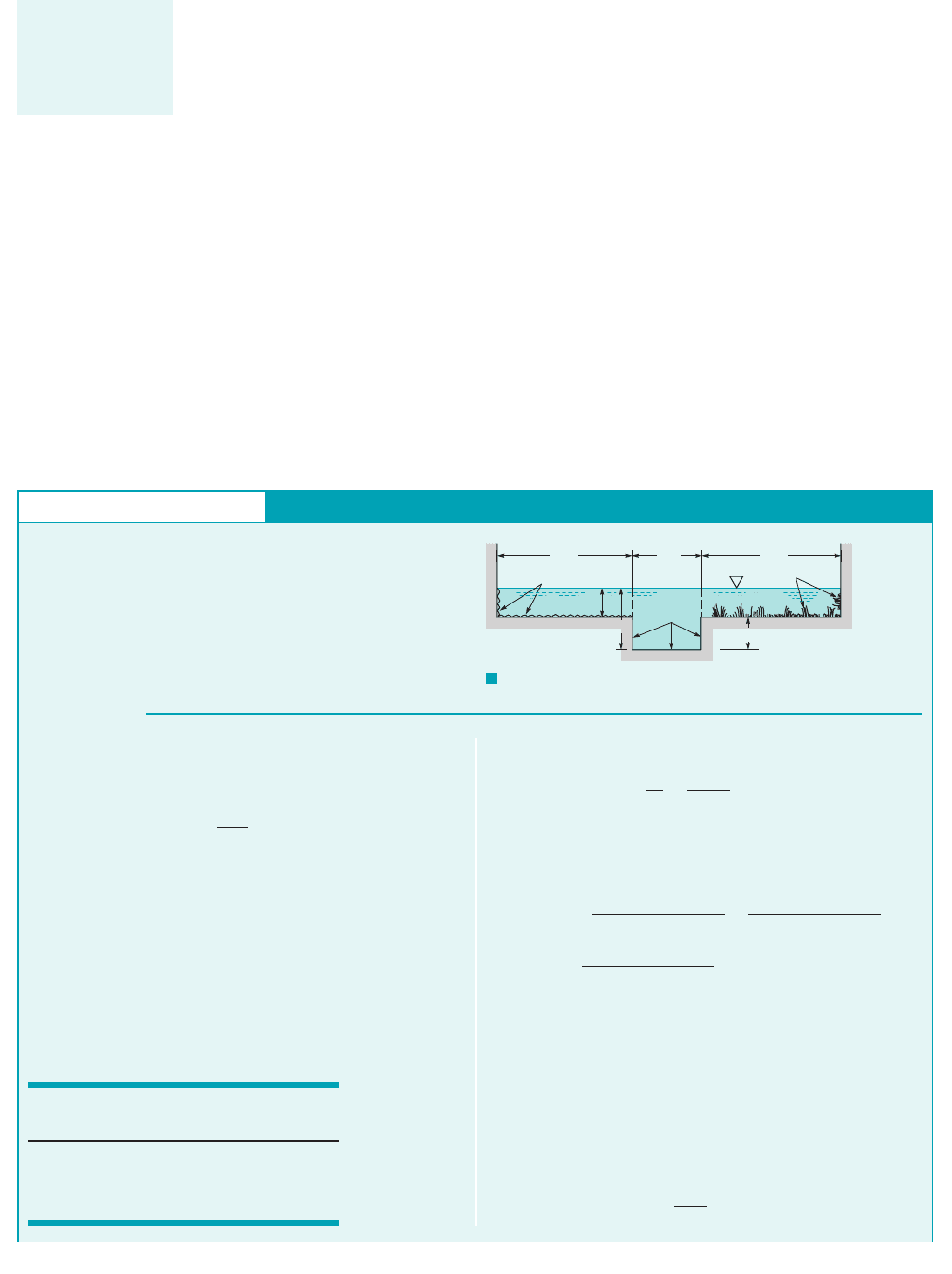
In many man-made channels and in most natural channels, the surface roughness 1and hence
the Manning coefficient2varies along the wetted perimeter of the channel. A drainage ditch, for
example, may have a rocky bottom surface with concrete side walls to prevent erosion. Thus,
the effective n will be different for shallow depths than for deep depths of flow. Similarly, a river
channel may have one value of n appropriate for its normal channel and another very different
value of n during its flood stage when a portion of the flow occurs across fields or through
floodplain woods. An ice-covered channel usually has a different value of n for the ice than for
the remainder of the wetted perimeter 1Ref. 72. 1Strictly speaking, such ice-covered channels are
not “open” channels, although analysis of their flow is often based on open-channel flow
equations. This is acceptable, since the ice cover is often thin enough so that it represents a fixed
boundary in terms of the shear stress resistance, but it cannot support a significant pressure
differential as in pipe flow situations.2
A variety of methods has been used to determine an appropriate value of the effective
roughness of channels that contain subsections with different values of n. Which method gives the
most accurate, easy-to-use results is not firmly established, since the results are nearly the same
for each method 1Ref. 52. A reasonable approximation is to divide the channel cross section into N
subsections, each with its own wetted perimeter, area, and Manning coefficient, The
values do not include the imaginary boundaries between the different subsections. The total flowrate
is assumed to be the sum of the flowrates through each section. This technique is illustrated by
Example 10.7.
P
i
n
i
.A
i
,P
i
,
10.4 Uniform Depth Channel Flow 553
For many open
channels, the sur-
face roughness
varies across the
channel.
GIVEN Water flows along the drainage canal having the proper-
ties shown in Fig. E10.6a. The bottom slope is
.
FIND Estimate the flowrate when the depth is
0.6 ft ⫽ 1.4 ft.
y ⫽ 0.8 ft ⫹
0.002
S
0
⫽ 1 ft
Ⲑ
500 ft ⫽
Uniform Flow, Variable Roughness
E
XAMPLE 10.6
S
OLUTION
We divide the cross section into three subsections as is indicated
in Fig. E10.6a and write the flowrate as
where for each section
The appropriate values of and are listed in
Table E10.6. Note that the imaginary portions of the perimeters
between sections 1denoted by the vertical dashed lines in Fig.
E10.6a2are not included in the That is, for section 122
and
P
2
⫽ 2 ft ⫹ 210.8 ft2⫽ 3.6 ft
A
2
⫽ 2 ft 10.8 ⫹ 0.62 ft ⫽ 2.8 ft
2
P
i
.
n
i
A
i
, P
i
, R
hi
,
Q
i
⫽
1.49
n
i
A
i
R
2
Ⲑ
3
h
i
S
0
1
Ⲑ
2
Q
3
,Q ⫽ Q
1
⫹ Q
2
⫹
F I G U R E E10.6
a
(2)
n
2
=
0.015
0.8 ft
y
(3)
0.6 ft
(1)
n
1
= 0.020
n
3
= 0.030
3 ft2 ft3 ft
■ TABLE E10.6
i ( ) (ft) (ft)
1 1.8 3.6 0.500 0.020
2 2.8 3.6 0.778 0.015
3 1.8 3.6 0.500 0.030
n
i
ft
2
R
hi
P
i
A
i
so that
Thus, the total flowrate is
or
(Ans)
COMMENTS If the entire channel cross section were con-
sidered as one flow area, then and
or
The flowrate is given by Eq. 10.20, which can be writ-
ten as
Q ⫽
1.49
n
eff
AR
2
Ⲑ
3
h
S
1
Ⲑ
2
0
0.593 ft.
R
h
⫽ A
Ⲑ
P ⫽ 6.4 ft
2
Ⲑ
10.8 ft ⫽P
2
⫹ P
3
⫽10.8 ft,P ⫽ P
1
⫹
A
2
⫹ A
3
⫽ 6.4 ft
2
A ⫽ A
1
⫹
Q ⫽ 16.8 ft
3
Ⲑ
s
⫹
11.8 ft
2
210.500 ft2
2
Ⲑ
3
0.030
d
⫻ c
11.8 ft
2
210.500 ft2
2
Ⲑ
3
0.020
⫹
12.8 ft
2
210.778 ft2
2
Ⲑ
3
0.015
Q ⫽ Q
1
⫹ Q
2
⫹ Q
3
⫽ 1.4910.0022
1
Ⲑ
2
R
h
2
⫽
A
2
P
2
⫽
2.8 ft
2
3.6 ft
⫽ 0.778 ft
JWCL068_ch10_534-578.qxd 9/30/08 8:33 AM Page 553
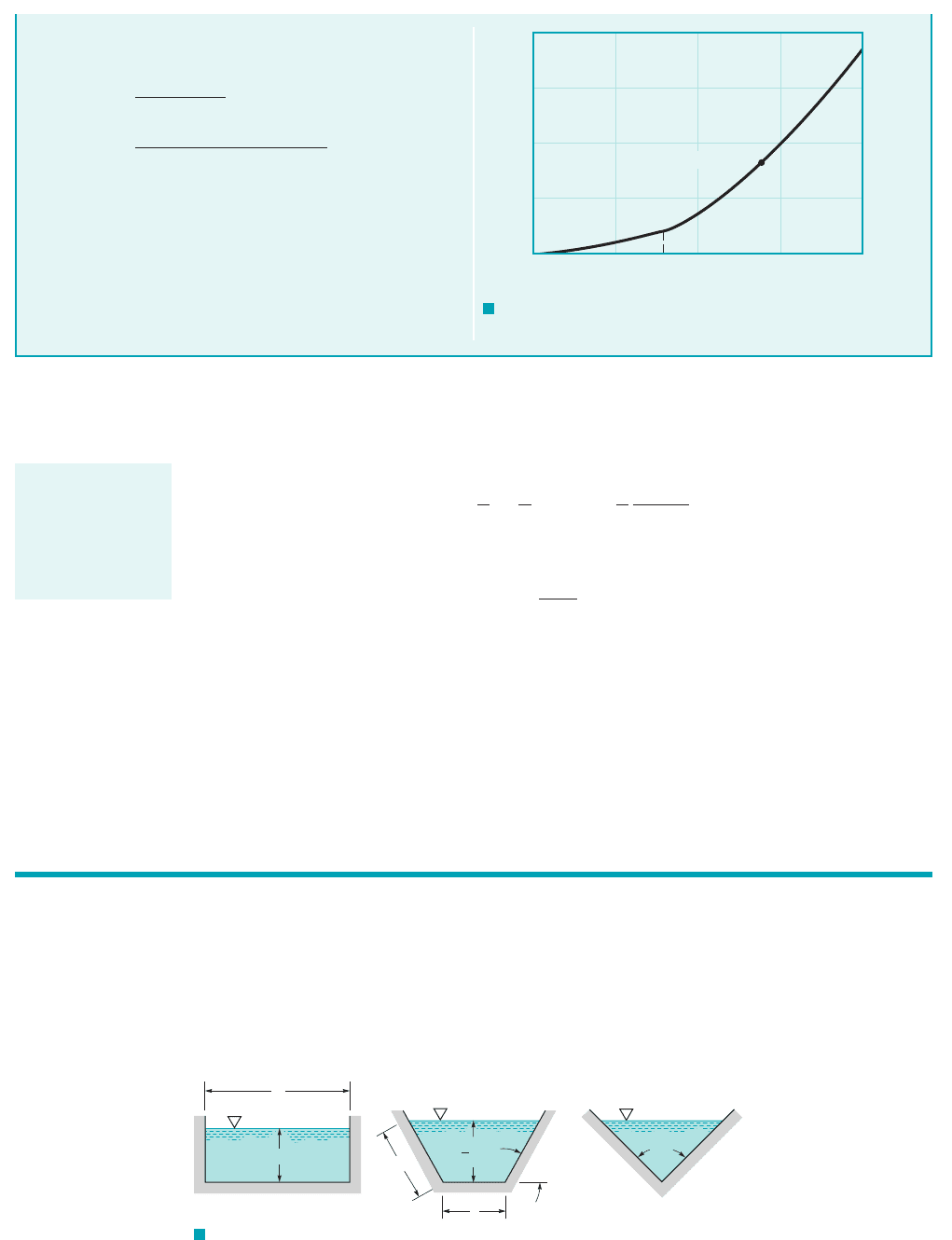
One type of problem often encountered in open-channel flows is that of determining the best
hydraulic cross section defined as the section of the minimum area for a given flowrate, Q, slope,
and roughness coefficient, n. By using we can write Eq. 10.20 as
which can be rearranged as
where the quantity in the parentheses is a constant. Thus, a channel with minimum A is one with
a minimum P, so that both the amount of excavation needed and the amount of material to line
the surface are minimized by the best hydraulic cross section.
The best hydraulic cross section possible is that of a semicircular channel. No other shape
has as small a wetted perimeter for a given area. It is often desired to determine the best shape for
a class of cross sections. The results (given here without proof) for rectangular, trapezoidal (with
60° sides), and triangular shapes are shown in Fig. 10.11. For example, the best hydraulic cross
section for a rectangle is one whose depth is half its width; for a triangle it is a 90° triangle.
A a
nQ
kS
1
2
0
b
3
5
P
2
5
Q
k
n
A a
A
P
b
2
3
S
1
2
0
k
n
A
5
3
S
1
2
0
P
2
3
R
h
A
PS
0
,
554 Chapter 10 ■ Open-Channel Flow
where is the effective value of n for this channel. With
as determined above, the value of is found to be
As expected, the effective roughness 1Manning n2is between the
minimum and maximum values for
the individual subsections.
By repeating the calculations for various depths, y, the results
shown in Fig. E10.6b are obtained. Note that there are two distinct
portions of the graph—one when the water is contained entirely
within the main, center channel the other when the wa-
ter overflows into the side portions of the channel 1y 7 0.8 ft2.
1y 6 0.8 ft2;
1n
3
0.03021n
2
0.0152
1.4916.4210.5932
2
3
10.0022
1
2
16.8
0.0179
n
eff
1.49AR
2
3
h
S
0
1
2
Q
n
eff
Q 16.8 ft
3
s
n
eff
(1.4 ft, 16.8 ft
3
/s)
40
30
20
10
0
0 0.5 1
y, ft
Q, ft
3
/s
1.5 2
F I G U R E E10.6
b
For a given flow-
rate, the channel of
minimum area is
denoted as the best
hydraulic cross
section.
F I G U R E 10.11 Best hydraulic cross sections for a rectangle, a 60º
trapezoid, and a triangle.
y = b/2
b
b
b
60°
√
y =
3
b/2
90°
10.5 Gradually Varied Flow
In many situations the flow in an open channel is not of uniform depth along the
channel. This can occur because of several reasons: The bottom slope is not constant, the cross-
sectional shape and area vary in the flow direction, or there is some obstruction across a portion
of the channel. Such flows are classified as gradually varying flows if .
If the bottom slope and the energy line slope are not equal, the flow depth will vary along
the channel, either increasing or decreasing in the flow direction. In such cases
, and the right-hand side of Eq. 10.10 is not zero. Physically, the difference between thedV
dx 0
dy
dx 0,
dy
dx 1
1y constant2
JWCL068_ch10_534-578.qxd 9/23/08 11:53 AM Page 554
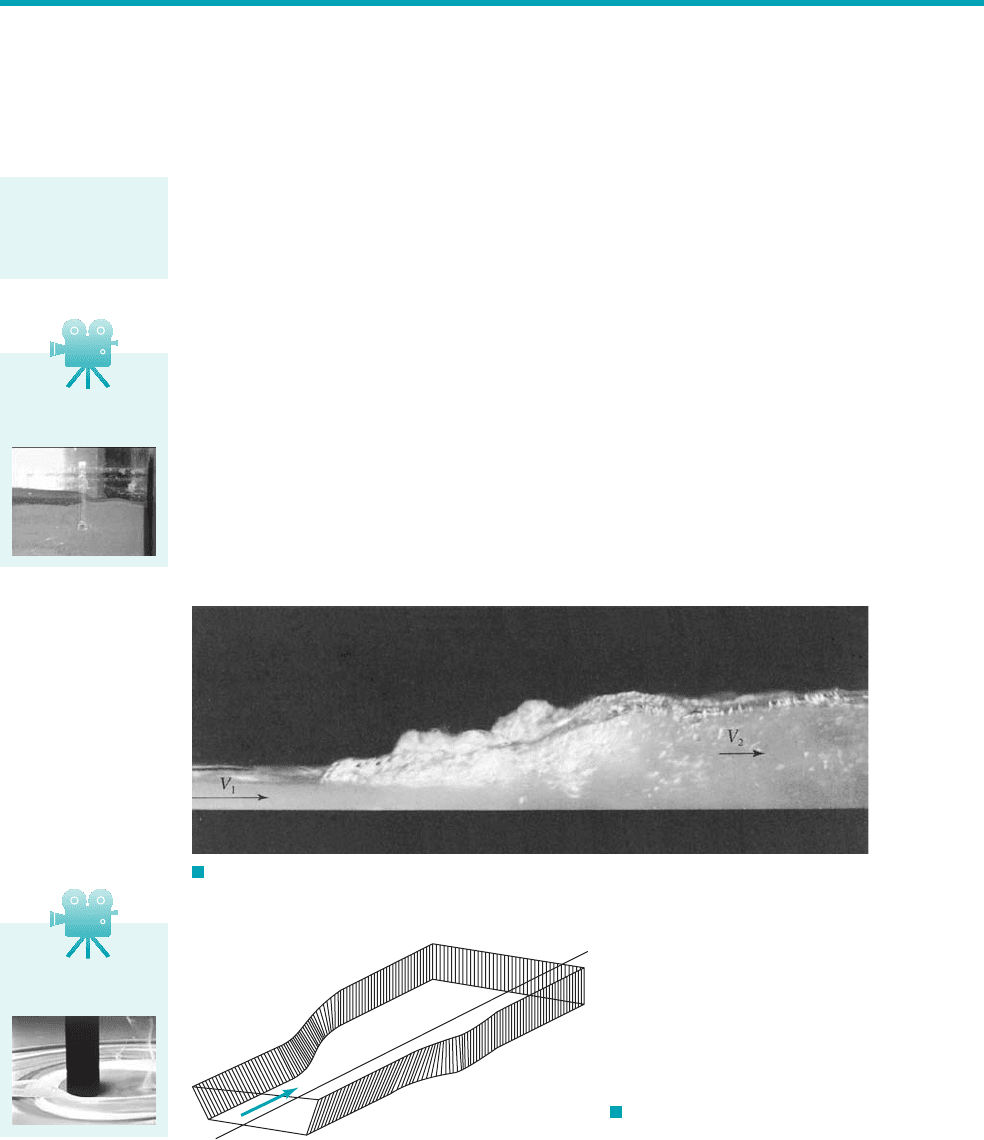
component of weight and the shear forces in the direction of flow produces a change in the fluid
momentum that requires a change in velocity and, from continuity considerations, a change in
depth. Whether the depth increases or decreases depends on various parameters of the flow, with
a variety of surface profile configurations [flow depth as a function of distance, ] possible
(Refs. 5, 9).
y ⫽ y1x2
10.6 Rapidly Varied Flow 555
F I G U R E 10.12 Hydraulic jump.
F I G U R E 10.13 Rapidly varied
flow may occur in a channel transition section.
Flow
In many cases the
flow depth may
change significantly
in a short distance.
V10.8 Erosion in a
channel
V10.9 Bridge pier
scouring
10.6 Rapidly Varied Flow
In many open channels, flow depth changes occur over a relatively short distance so that
Such rapidly varied flow conditions are often quite complex and difficult to analyze in a precise
fashion. Fortunately, many useful approximate results can be obtained by using a simple one-
dimensional model along with appropriate experimentally determined coefficients when necessary.
In this section we discuss several of these flows.
Some rapidly varied flows occur in constant area channels for reasons that are not immediately
obvious. The hydraulic jump is one such case. As is indicated in Fig. 10.12, the flow may change
from a relatively shallow, high-speed condition into a relatively deep, low-speed condition within
a horizontal distance of just a few channel depths. Other rapidly varied flows may be due to a
sudden change in the channel geometry such as the flow in an expansion or contraction section of
a channel as is indicated in Fig. 10.13.
In such situations the flow field is often two- or three-dimensional in character. There may be
regions of flow separation, flow reversal, or unsteady oscillations of the free surface. For the purpose
of some analyses, these complexities can be neglected and a simplified analysis can be undertaken.
In other cases, however, it is the complex details of the flow that are the most important property of
the flow; any analysis must include their effects. The scouring of a river bottom in the neighborhood
of a bridge pier, as is indicated in Fig. 10.14, is such an example. A one- or two-dimensional model
of this flow would not be sufficient to describe the complex structure of the flow that is responsible
for the erosion near the foot of the bridge pier.
Many open-channel flow-measuring devices are based on principles associated with rapidly
varied flows. Among these devices are broad-crested weirs, sharp-crested weirs, critical flow flumes,
and sluice gates. The operation of such devices is discussed in the following sections.
dy
Ⲑ
dx ⬃ 1.
JWCL068_ch10_534-578.qxd 9/23/08 11:53 AM Page 555
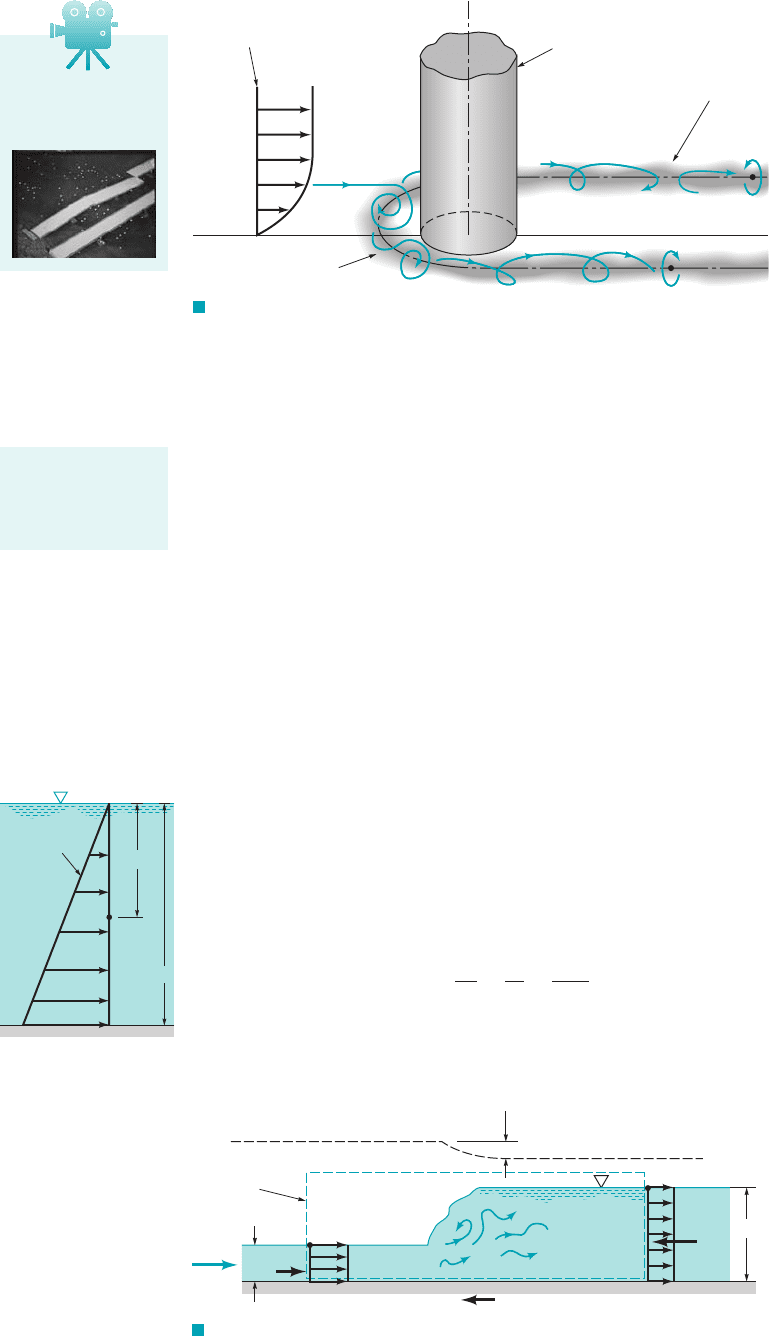
10.6.1 The Hydraulic Jump
Observations of flows in open channels show that under certain conditions it is possible that the
fluid depth will change very rapidly over a short length of the channel without any change in the
channel configuration. Such changes in depth can be approximated as a discontinuity in the free-
surface elevation For reasons discussed below, this step change in depth is always
from a shallow to a deeper depth—always a step up, never a step down.
Physically, this near discontinuity, called a hydraulic jump, may result when there is a conflict
between the upstream and downstream influences that control a particular section 1or reach2of a channel.
For example, a sluice gate may require that the conditions at the upstream portion of the channel
1downstream of the gate2be supercritical flow, while obstructions in the channel on the downstream
end of the reach may require that the flow be subcritical. The hydraulic jump provides the mechanism
1a nearly discontinuous one at that2to make the transition between the two types of flow.
The simplest type of hydraulic jump occurs in a horizontal, rectangular channel as is indicated
in Fig. 10.15. Although the flow within the jump itself is extremely complex and agitated, it is
reasonable to assume that the flow at sections 112and 122is nearly uniform, steady, and one-
dimensional. In addition, we neglect any wall shear stresses, within the relatively short segment
between these two sections. Under these conditions the x component of the momentum equation
1Eq. 5.222for the control volume indicated can be written as
where, as indicated by the figure in the margin, the pressure force at either section is hydrostatic.
That is, and where and are
the pressures at the centroids of the channel cross sections and b is the channel width. Thus, the
momentum equation becomes
(10.21)
In addition to the momentum equation, we have the conservation of mass equation 1Eq. 5.122
(10.22)y
1
bV
1
y
2
bV
2
Q
y
1
2
2
y
2
2
2
V
1
y
1
g
1V
2
V
1
2
p
c2
gy
2
2p
c1
gy
1
2F
2
p
c2
A
2
gy
2
2
b
2,F
1
p
c1
A
1
gy
2
1
b
2
F
1
F
2
rQ1V
2
V
1
2 rV
1
y
1
b1V
2
V
1
2
t
w
,
1dy
dx 2.
556 Chapter 10 ■ Open-Channel Flow
F I G U R E 10.14 The complex three-dimensional flow structure around a bridge pier.
Upstream velocity
profile
Bridge pier
Horseshoe vortex
Scouring of
channel bottom
A hydraulic jump is
a steplike increase
in fluid depth in an
open channel.
F I G U R E 10.15 Hydraulic jump geometry.
Q
Control
volume
(1)
V
1
F
1
y
1
y
2
F
2
V
2
(2)
h
L
Energy
line
x
w
= 0
τ
p
c
y
1
y
1
/2
V10.10 Big Sioux
River bridge
collapse
JWCL068_ch10_534-578.qxd 9/23/08 11:53 AM Page 556
